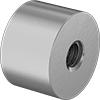Filter by
Thread Size
Component
Material
Diameter
Thread Direction
Thread Type
Thread Fit
Flange Material
Dynamic Thrust Load Capacity
Flange Diameter
Threading
Height
Tensile Strength
DFARS Specialty Metals
Export Control Classification Number (ECCN)



























